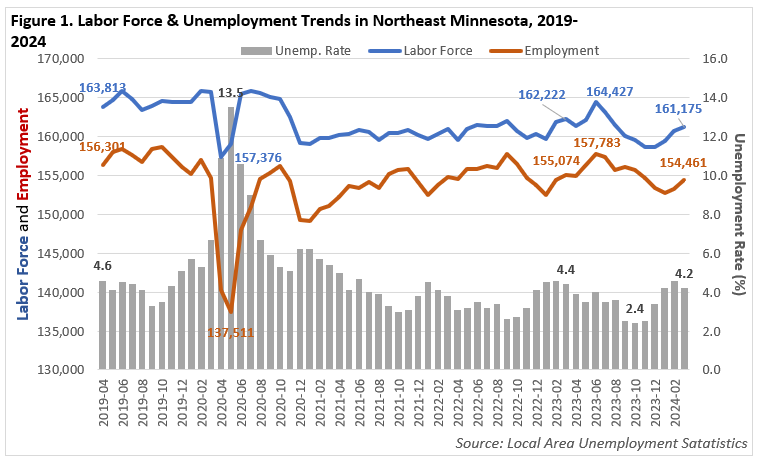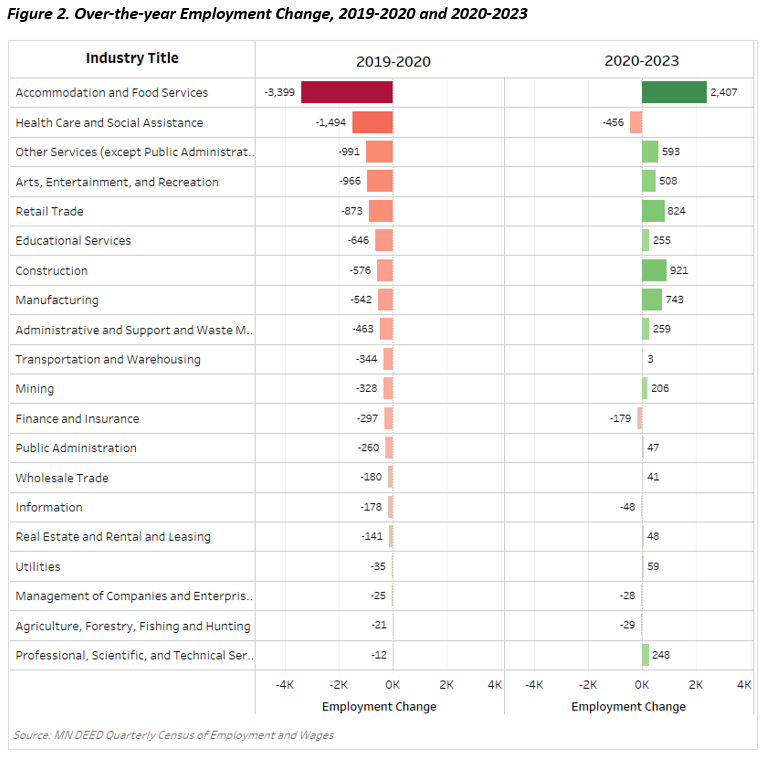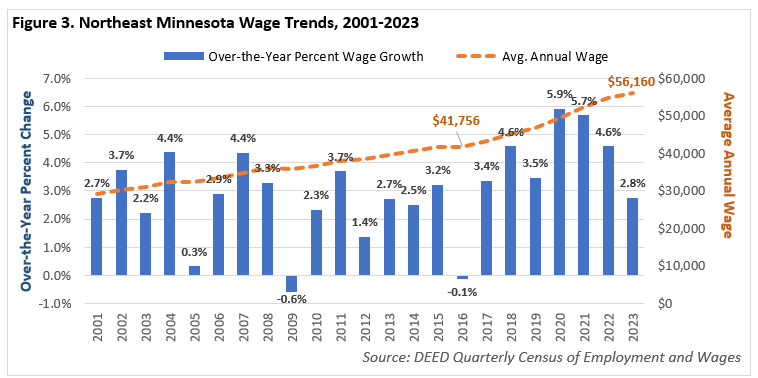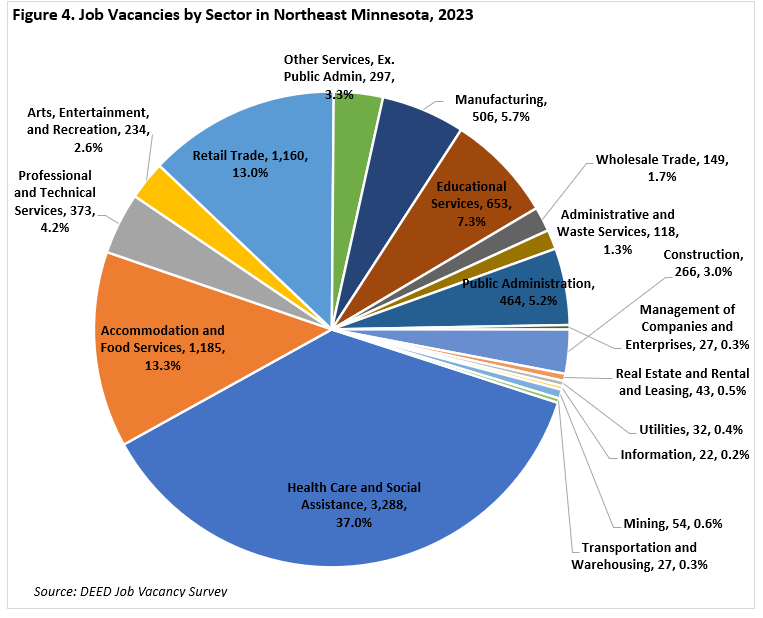
by Carson Gorecki
June 2024
After four long years, Minnesota's labor force is nearing pre-pandemic levels, an indication of economic resilience and recovery. However, Northeast Minnesota is one of four regions that has not yet reached that milestone (see Table 1). According to DEED's Local Area Unemployment Statistics, the labor force of the northeastern corner of the state remains 2.1% lower than in 2019, a deficit equivalent to just under 3,450 workers as of March of this year. The number of employed persons had a slightly smaller deficit.
The good news is that the discrepancy between labor force and employment reflects a relatively large percent decline (-23.7%) in the number of unemployed persons. That decline represented an average of 1,760 fewer people who were looking but had not found work during the twelve-month period ending in March. By this measure the regional labor market remained tight at the beginning of 2024, but there were some signs of potential loosening.
| Table 1. Labor Force, Employment, and Unemployment Percent Change by Area, 2019-2024* | |||||||
|---|---|---|---|---|---|---|---|
| Measure | Minnesota | 7- County Twin Cities Metro Area | Northwest Minnesota | Northeast Minnesota | Southeast Minnesota | Southwest Minnesota | Central Minnesota |
| Labor Force | -0.3% | -0.4% | 1.7% | -2.1% | 0.4% | -1.8% | -0.6% |
| Employment | 0.2% | -0.1% | 2.7% | -1.1% | 1.0% | -1.2% | 0.0% |
| Unemployment | -14.4% | -9.8% | -21.8% | -23.7% | -17.8% | -19.7% | -14.1% |
| *12 month rolling average ending March 2024, Source: DEED Local Area Unemployment Statistics | |||||||
Detailed regional data shed some more light on recent labor force and unemployment trends. Since March 2021, when the pandemic labor force tumult began to calm, the labor force has added a net of just over 1,400 workers. That is an average monthly increase of 39 additional workers across the seven-county area. More recently, that growth slowed and even turned toward decline. Over the past year the labor force shrank by more than 1,000 workers, equivalent to an average monthly loss of 87 workers.
However, those that were in the labor force were less likely to be unemployed. The average unemployment rate for the 12 months ending in March 2024 was 3.5%. Even in the relatively tight labor market conditions of the three years leading up to the pandemic, the regional rate was on average a full percentage point higher (4.6% from 2017-2019). The 2.4% rate recorded in October 2023 holds the record as the lowest monthly rate in the history of the series for Northeast Minnesota, which dates back to 1990. The regional monthly unemployment rate has dipped below 3% just five times, all in the last two years (see Figure 1).

The most recent unemployment rate was lower now than it was in 2019 in all seven counties (see Table 2). The regional rate was down a fifth from five years prior. Local labor force trends were slightly more mixed. Only Aitkin had more people in the labor force in March 2024 than in 2019, despite (or maybe due to) being the oldest county in the state. Compared to 2019, the largest remaining labor force deficits existed in Lake (-5.4%), Cook (-4.2%) and Koochiching (-3.4%) counties. Koochiching also had the largest over-the-year decline (-2.5%) while Itasca (+0.7%) had the largest relative labor force growth. Only two counties (Lake and Itasca) added workers over the year.
| Table 2. Unemployment Rate and Labor Force by County in Northeast Minnesota, 2019-2024 | |||||
|---|---|---|---|---|---|
| Area | Unemployment Rate | Labor Force | |||
| Current Rate (Mar 2024) | Pre-Pandemic Rate (Mar 2019) | Current Labor Force (Mar 2024) | Difference from Pre-Pandemic (Mar 2019) | Over the Year Change | |
| Northeast Minnesota | 4.2% | 5.3% | 161,175 | -3,124 | -1,047 |
| Duluth-Superior MSA | 4.0% | 4.8% | 141,437 | -2,728 | -973 |
| Aitkin Co. | 6.5% | 8.6% | 7,535 | +245 | -20 |
| Carlton Co. | 4.4% | 5.6% | 17,715 | -405 | -177 |
| Cook Co. | 5.6% | 6.0% | 2,773 | -121 | -13 |
| Itasca Co. | 5.6% | 7.0% | 21,804 | -65 | +154 |
| Koochiching Co. | 4.6% | 6.0% | 5,703 | -216 | -140 |
| Lake Co. | 3.2% | 4.6% | 5,123 | -294 | +15 |
| St. Louis Co. | 3.6% | 4.6% | 100,522 | -2,268 | -866 |
| City of Duluth | 2.7% | 3.5% | 45,255 | -707 | -282 |
| Source: Local Area Unemployment Statistics | |||||
According to new 2023 annual averages from DEED's Quarterly Census of Employment & Wages, Northeast Minnesota was home to 138,333 jobs at nearly 9,300 business establishments. In 2023, those jobs brought home over $7.77 billion in total wages for an average annual wage of $56,160.
Of the six planning regions in the state, Northeast Minnesota saw the largest percent employment decline in 2020 (-8.2%), due to the Pandemic Recession. After the loss of about 11,800 jobs from 2019 into 2020, regional employment has steadily recovered, but not fully. As of 2023, employment levels remained about 5,350 jobs short of pre-pandemic job counts, and the 3.7% deficit remained the largest among the planning regions (see Table 3).
More recently, the local economy added 1,817 jobs between 2022 and 2023, an increase of 1.3%. The rate of employment growth, beginning at 1.9% in 2020-2021 and dropping to 1.5% in 2021-2022, has slowed slightly each year following the initial downturn in 2020.
| Table 3. Over-the-Year Percent Employment Change by Area, 2019-2023 | ||||||
|---|---|---|---|---|---|---|
| Area | 2019-2020 | 2020-2021 | 2021-2022 | 2022-2023 | 2019-2023 Percent Change | 2019-2023 Numeric Change |
| Northeast Minnesota | -8.2% | +1.9% | +1.5% | +1.3% | -3.7% | -5,350 |
| Central Minnesota | -5.4% | +2.0% | +2.1% | +1.8% | +0.3% | +735 |
| Northwest Minnesota | -5.5% | +3.5% | +1.6% | +1.4% | +0.7% | +1,631 |
| Twin Cities Metro Area | -7.4% | +2.1% | +3.0% | +1.4% | -1.2% | -22,114 |
| Southeast Minnesota | -5.5% | +2.1% | +0.9% | +1.5% | -1.3% | -3,141 |
| Southwest Minnesota | -5.3% | +1.0% | +1.7% | +0.7% | -2.1% | -3,683 |
| State of Minnesota | -6.7% | +2.5% | +2.9% | +1.7% | +0.1% | +1,632* |
| *Regions may not sum to state total due to unallocated statewide employment. Source: MN DEED Quarterly Census of Employment and Wages | ||||||
Every industry sector in Northeast Minnesota experienced employment loss from 2019 into 2020. However, not all industries experienced severe employment losses, and individual trajectories since 2020 have varied. Service-providing sectors such as Accommodation & Food Services, Health Care & Social Assistance, and Other Services experienced large losses in 2020.
From that point their fates diverged. Accommodation & Food Services, Other Services, and most other service-providing sectors experienced recoveries to varying extents over the subsequent three years. Health Care & Social Assistance along with Finance & Insurance were notable exceptions. Their losses continued, albeit at a much slower pace compared to 2020. Only in 2022-2023 did Health Care & Social Assistance start to add jobs back, with 474 net new jobs. Likewise, Public Administration saw three years of consecutive employment loss followed by one year of growth, which was large enough to reverse the deficit (see Figure 2).

Retail Trade, the second-largest employing sector in the region, followed up a smaller-than-average decline in 2020 with above average growth in the subsequent three years. And while still in the red, Retail Trade had the smallest remaining employment deficits (-0.3%) among service-providing sectors when compared to 2019 levels.
The two service-providing sectors that bucked the trend and ended 2023 with more jobs than in 2019 were Professional, Scientific & Technical Services and Utilities. What these sectors share is a close association with the goods-producing sectors that largely fared well over the pandemic period, like Construction and Manufacturing. Almost all the employment growth in Professional, Scientific, and Technical Services occurred between 2020 and 2021. Utilities followed one year of relatively minor losses with three consecutive years of gains. The same trend occurred in Manufacturing and Construction, the two sectors that were in the top three for absolute and relative employment change over the last four years.
Wages were equally dynamic over the past several years. The average annual wage in 2023 in Northeast Minnesota was $56,160. Up 2.8% from 2022, wage growth slowed from earlier, more robust increases. The regional average wage was up 7.4% from 2021, up 13.6% from 2020, and up 20.3% from 2019 (see Figure 3).

Just like employment trends, wage outcomes varied greatly by sector. In general, lower-paying sectors saw larger wage gains. The lowest-paying sector, Accommodation & Food Services, saw the largest relative wage growth (+31.2%) since 2019. Arts, Entertainment & Recreation and Retail Trade – two more lower wage sectors – also saw above-average wage gains. Finance & Insurance, Health Care & Social Insurance and Professional, Scientific & Technical Services were the sectors with above average wages and above-average wage growth (see Table 4).
| Table 4. Wage Trends by Sector in Northeast Minnesota, 2019-2023 | |||
|---|---|---|---|
| Industry Title | 2019-2023 Percent Change | 2022-2023 Percent Change | 2023 Annual Average Wage |
| Accommodation and Food Services | 31.2% | 5.9% | $22,516 |
| Finance and Insurance | 30.3% | 2.1% | $77,012 |
| Real Estate and Rental and Leasing | 29.7% | 7.7% | $42,224 |
| Arts, Entertainment, and Recreation | 25.3% | 6.7% | $30,680 |
| Retail Trade | 22.7% | 1.9% | $33,436 |
| Health Care and Social Assistance | 22.3% | 3.6% | $63,232 |
| Professional, Scientific, and Technical Services | 21.8% | 5.9% | $79,300 |
| Administrative Support and Waste Management Services | 21.7% | 5.5% | $36,972 |
| Total, All Industries | 20.3% | 2.8% | $56,160 |
| Agriculture, Forestry, Fishing and Hunting | 19.8% | 12.6% | $47,840 |
| Mining | 19.3% | -8.5% | $116,532 |
| Construction | 18.0% | 4.7% | $75,764 |
| Wholesale Trade | 18.0% | 5.4% | $73,788 |
| Public Administration | 16.5% | 4.2% | $62,452 |
| Other Services (except Public Administration) | 15.7% | 2.4% | $33,332 |
| Transportation and Warehousing | 14.8% | 1.2% | $61,620 |
| Manufacturing | 14.0% | 2.5% | $70,200 |
| Educational Services | 13.5% | 2.4% | $52,780 |
| Information | 11.9% | 5.3% | $53,144 |
| Management of Companies and Enterprises | 11.5% | -4.7% | $95,732 |
| Utilities | 6.7% | 4.8% | $109,980 |
| Source: MN DEED Quarterly Census of Employment and Wages | |||
Conversely, the smallest relative wage gains from 2019-2023 occurred in two of the highest-paying sectors: Management of Companies and Utilities. Mining, the sector with the highest wages, had strong wage gains early on but experienced the largest wage losses over the last year. Other Services was one of the lowest-paying sectors that experienced below-average gains.
With an estimated 9,000 job vacancies in 2023, the number of job openings fell by more than a quarter from the previous year. While the number of vacancies fell to the lowest point since 2020, the overall level remained higher than pre-pandemic levels. From 2016-2019, regional job vacancies averaged around 7,750. Despite having the fewest total vacancies among the planning regions, at 6.6%, Northeast Minnesota had the highest vacancy rate, which is the comparison of open jobs to filled jobs. The statewide rate in 2023 was 5.1%.
As in previous years, the sector with the most vacancies was Health Care & Social Assistance, with nearly 3,300 regional openings or 37% (see Figure 4). Accommodation & Food Services (13.3% of vacancies) and Retail Trade made up the next largest shares. The share of vacancies in Health Care & Social Assistance and Accommodation & Food Services fell over the year, down from 48.1% and 18.6% respectively. Given the overall decrease, most sectors saw declines in the number of vacancies. The sectors with growth in vacancies were Construction, Manufacturing, Mining, Professional, Scientific & Technical Services, Public Administration, Other Services, Wholesale Trade and Management of Companies.

The occupations with the most vacancies were Healthcare Practitioners & Technical (1,244), Food Preparation & Serving Related (1,043), Healthcare Support (982) and Sales & Related (826). The highest vacancy rates were for the Installation, Maintenance & Repair (11.9%), Legal (11.6%), Personal Care & Service (11.1%) and both Healthcare Practitioners & Technical and Healthcare Support occupational groups listed above (10.7%-10.9%). Conversely, Construction & Extraction (0.8%), Computer & Mathematical (1.6%) and Management (1.9%) had the lowest vacancy rates in the region.
The median wage offer for all vacancies in the region rose 6.5% to $18.49 in 2023 from $17.36 an hour in 2022. The 6.5% wage offer growth in Northeast Minnesota trailed the 7.4% statewide wage offer growth. The highest median wage offers were for Management ($39.89), Architecture & Engineering ($36.71), Computer & Mathematical ($35.32) and Healthcare Practitioners & Technical ($34.84) occupations. The lowest wage offers were for Personal Care & Service ($14.10), Food Preparation & Serving Related ($14.24), Healthcare Support ($15.95) and Sales & Related ($16.06) positions.
Part-time positions made up 30% of vacancies and temporary openings accounted for 10% of vacancies. Just over a third of all vacancies required some type of postsecondary education or training, and 45% required a certification. Vacancies for positions requiring certifications made up the highest shares among Legal (100%), Healthcare Practitioners & Technical (99%), Community & Social Service (91%) and Protective Service (90%) occupations.
Forty-one percent of vacancies required at least one year of work experience, but that varied significantly by occupational group. At the high end were Management (88%), Computer & Mathematical (79%), Architecture & Engineering (77%) and Business & Financial Operations (77%). At the low end were Internships (2%), Healthcare Support (3%) and Transportation & Material Moving Occupations (9%).
The decline in the number of job vacancies combined with slowing or reversing wage, employment, and labor force growth point toward a potential loosening of the historically tight labor market in Northeast Minnesota. At the same time, unemployment remains at record lows, indicating continued demand for workers in the region. Looking back a year from now, this period could prove to be one of transition from the years-long recovery from the Pandemic Recession into a new, post-pandemic equilibrium. Only time and the data available will tell.